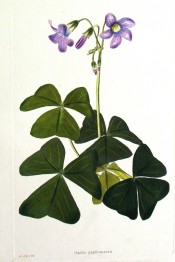Oxalis palustris St. Hil.
Frost-tender bulbous perennial with 3 leaflets, somewhat triangular, with rounded sides, somewhat like the wings of a butterfly, and umbels of many purple flowers. To 8cm. [Don, LBC no.1551/1831].
Horticultural & Botanical History
Oxalis palustris and O. papiloniaceae were often treated as separate species, introduced to Britain in 1828 and 1819 respectively. O. palustris is described as having lilac flowers. [JD]. ‘This [Oxalis papilionaceae] is a native of Mexico, and was introduced by Mr. Barclay, from whom we received it. The name has probably been given to it from the resemblance, which we may fancy in the leaflets, to the wings of a butterfly.’ [LBC no.1551/1831].
History at Camden Park
Listed in all published catalogues [B.377/1843].
Notes
A plant growing in the gardens and identified as Oxalis latifolia Kunth bears a very strong resemblance to Oxalis palustris. In the wild these plants appear to occupy the same range, at least in Mexico. I have seen nothing in the literature that relates these plants but this should be explored. Oxalis latifolia Kunth is a very common garden weed in the Camden area.
Published Jan 28, 2010 - 04:37 PM | Last updated Jul 29, 2010 - 01:40 PM
| Family | Oxalidaceae |
|---|---|
| Category | |
| Region of origin | South Africa, Cape district |
| Synonyms |
|
| Common Name | |
| Name in the Camden Park Record |
Oxalis papilionacea |
| Confidence level | high |


